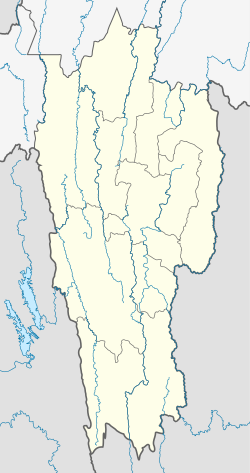Draft:Kawrtethawveng
| This is a draft article. It is a work in progress open to editing by anyone. Please ensure core content policies are met before publishing it as a live Wikipedia article. Find sources: Google (books · news · scholar · free images · WP refs) · FENS · JSTOR · TWL Last edited by Rsjaffe (talk | contribs) 9 hours ago. (Update)
Finished drafting? or |
This article may incorporate text from a large language model. (May 2025) |
Kawrtethawveng | |
|---|---|
Village | |
| Coordinates: 23°54′07″N 92°20′35″E / 23.9020°N 92.3430°E | |
| Country | India |
| State | Mizoram |
| District | Mamit |
| Population (2011) | |
• Total | 2,008 |
| Languages | |
| • Official | Mizo |
| Time zone | UTC+5:30 (IST) |
| PIN | 796441 |
| Vehicle registration | MZ-09 |
| Website | mizoram |
Kawrtethawveng is a village in Mamit district, in the Indian state of Mizoram. It is located in the Zawlnuam area of northwestern Mizoram, near the tri-junction border with Tripura and Assam.[1]
Geography
[edit]Kawrtethawveng is situated approximately 20 km from the sub-district headquarters at Kawrthah and about 40 km from the district headquarters at Mamit. The village lies in a hilly region surrounded by dense forests and agricultural land, characteristic of Mizoram's topography.[1] The area is part of the Indo-Burma biodiversity hotspot, with rich flora and fauna documented in regional ecological surveys.[2]
Demographics
[edit]According to the 2011 Census of India, Kawrtethawveng had a population of 2,008, with 1,040 males and 968 females, resulting in a sex ratio of approximately 930 females per 1,000 males.[3] The literacy rate is 82.02%, with male literacy at 82.50% and female literacy at 81.51%.[1] The village comprises around 370 households, predominantly inhabited by the Mizo people, who speak the Mizo language.[4]
Economy
[edit]The economy is primarily agrarian, with most families engaged in subsistence farming. Rice and maize are staple crops, while arecanut cultivation serves as a major cash crop.[1] A 2019 study by the Indian Council of Agricultural Research (ICAR) highlighted Kawrtethawveng's role in Mizoram's arecanut production, contributing to 12% of the state’s output.[5]
Infrastructure
[edit]Kawrtethawveng has basic infrastructure, including two primary schools and a health sub-centre.[1] The village is connected to Mamit (24 km away) via rural roads developed under the Pradhan Mantri Gram Sadak Yojana (PMGSY).[6] Electricity coverage reached 95% of households in 2022, as per Mizoram’s Power & Electricity Department.[7]
Culture
[edit]The village follows traditional Mizo customs, with Christianity being the predominant religion. Festivals like Chapchar Kut (a spring harvest festival) and Christmas are widely celebrated.[8] Community activities often revolve around the local Presbyterian church, which plays a central role in social cohesion.[9]
See also
[edit]References
[edit]- ^ a b c d e "Kawrtethawveng". District Rural Development Office, Mamit. Retrieved 25 May 2025.
- ^ "Geography of Mamit District". Mizoram State Gazetteer. Government of Mizoram. 2020. p. 89. ISBN 978-93-80122-12-5.
{{cite book}}: Check|isbn=value: checksum (help) - ^ "Primary Census Abstract Data Tables: Mizoram". Office of the Registrar General & Census Commissioner, India. Retrieved 25 May 2025.
- ^ Mizoram Human Development Report 2021 (Report). Planning & Programme Implementation Department, Government of Mizoram. p. 54. Retrieved 25 May 2025.
- ^ Lalrinawma, R. (2020). "Arecanut Cultivation in Mizoram: Challenges and Opportunities". Indian Journal of Agricultural Economics. 75 (3): 402–415. doi:10.1007/s41027-020-00276-9.
- ^ PMGSY Rural Road Connectivity Report: Mamit District (Report). Ministry of Rural Development, Government of India. 2023. Retrieved 25 May 2025.
- ^ "Mizoram Energy Statistics 2022". Department of Power & Electricity, Government of Mizoram. p. 22. Retrieved 25 May 2025.
- ^ Pachuau, Joy (2015). "Religious and Cultural Practices". The Mizo Society: Continuity and Change. Cambridge University Press. pp. 132–135. ISBN 978-1-107-10265-8.
{{cite book}}: Check|isbn=value: checksum (help) - ^ Verghese, B.G. (2001). "India's Northeast Resurgent". Economic and Political Weekly. 36 (28): 2659–2664. JSTOR 4410845.


